The Intel SSD 710 (200GB) Review
by Anand Lal Shimpi on September 30, 2011 8:53 PM EST- Posted in
- Storage
- SSDs
- Intel
- Intel SSD 710
AnandTech Storage Bench 2011
Last year we introduced our AnandTech Storage Bench, a suite of benchmarks that took traces of real OS/application usage and played them back in a repeatable manner. I assembled the traces myself out of frustration with the majority of what we have today in terms of SSD benchmarks.
Although the AnandTech Storage Bench tests did a good job of characterizing SSD performance, they weren't stressful enough. All of the tests performed less than 10GB of reads/writes and typically involved only 4GB of writes specifically. That's not even enough exceed the spare area on most SSDs. Most canned SSD benchmarks don't even come close to writing a single gigabyte of data, but that doesn't mean that simply writing 4GB is acceptable.
Originally I kept the benchmarks short enough that they wouldn't be a burden to run (~30 minutes) but long enough that they were representative of what a power user might do with their system.
Not too long ago I tweeted that I had created what I referred to as the Mother of All SSD Benchmarks (MOASB). Rather than only writing 4GB of data to the drive, this benchmark writes 106.32GB. It's the load you'd put on a drive after nearly two weeks of constant usage. And it takes a *long* time to run.
1) The MOASB, officially called AnandTech Storage Bench 2011 - Heavy Workload, mainly focuses on the times when your I/O activity is the highest. There is a lot of downloading and application installing that happens during the course of this test. My thinking was that it's during application installs, file copies, downloading and multitasking with all of this that you can really notice performance differences between drives.
2) I tried to cover as many bases as possible with the software I incorporated into this test. There's a lot of photo editing in Photoshop, HTML editing in Dreamweaver, web browsing, game playing/level loading (Starcraft II & WoW are both a part of the test) as well as general use stuff (application installing, virus scanning). I included a large amount of email downloading, document creation and editing as well. To top it all off I even use Visual Studio 2008 to build Chromium during the test.
The test has 2,168,893 read operations and 1,783,447 write operations. The IO breakdown is as follows:
| AnandTech Storage Bench 2011 - Heavy Workload IO Breakdown | ||||
| IO Size | % of Total | |||
| 4KB | 28% | |||
| 16KB | 10% | |||
| 32KB | 10% | |||
| 64KB | 4% | |||
Only 42% of all operations are sequential, the rest range from pseudo to fully random (with most falling in the pseudo-random category). Average queue depth is 4.625 IOs, with 59% of operations taking place in an IO queue of 1.
Many of you have asked for a better way to really characterize performance. Simply looking at IOPS doesn't really say much. As a result I'm going to be presenting Storage Bench 2011 data in a slightly different way. We'll have performance represented as Average MB/s, with higher numbers being better. At the same time I'll be reporting how long the SSD was busy while running this test. These disk busy graphs will show you exactly how much time was shaved off by using a faster drive vs. a slower one during the course of this test. Finally, I will also break out performance into reads, writes and combined. The reason I do this is to help balance out the fact that this test is unusually write intensive, which can often hide the benefits of a drive with good read performance.
There's also a new light workload for 2011. This is a far more reasonable, typical every day use case benchmark. Lots of web browsing, photo editing (but with a greater focus on photo consumption), video playback as well as some application installs and gaming. This test isn't nearly as write intensive as the MOASB but it's still multiple times more write intensive than what we were running last year.
As always I don't believe that these two benchmarks alone are enough to characterize the performance of a drive, but hopefully along with the rest of our tests they will help provide a better idea.
The testbed for Storage Bench 2011 has changed as well. We're now using a Sandy Bridge platform with full 6Gbps support for these tests. All of the older tests are still run on our X58 platform.
AnandTech Storage Bench 2011 - Heavy Workload
We'll start out by looking at average data rate throughout our new heavy workload test:
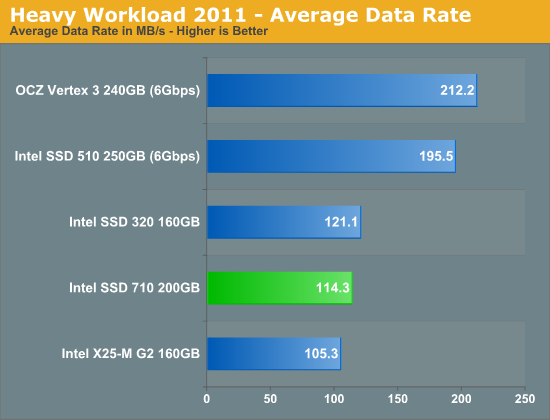
I threw in our standard desktop tests just to hammer home the point that the 710 simply shouldn't be used for client computing. Not only is MLC-HET overkill for client workloads, but the Intel SSD 320's firmware is better optimized for client computing.
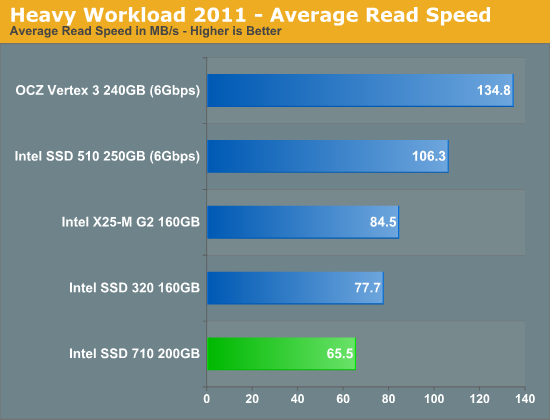
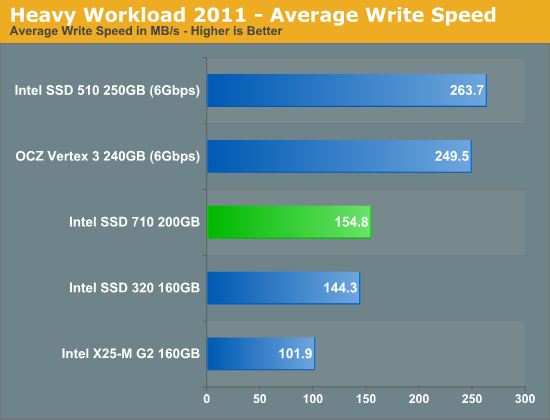
The next three charts just represent the same data, but in a different manner. Instead of looking at average data rate, we're looking at how long the disk was busy for during this entire test. Note that disk busy time excludes any and all idles, this is just how long the SSD was busy doing something:
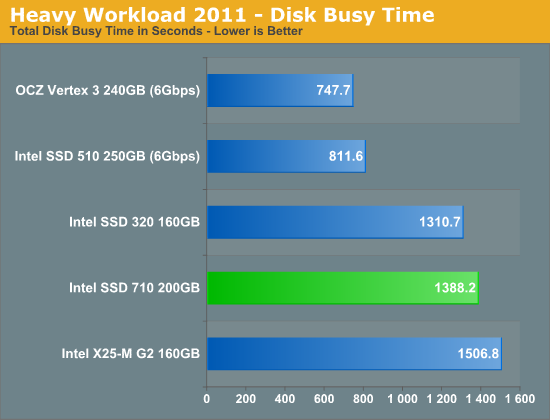
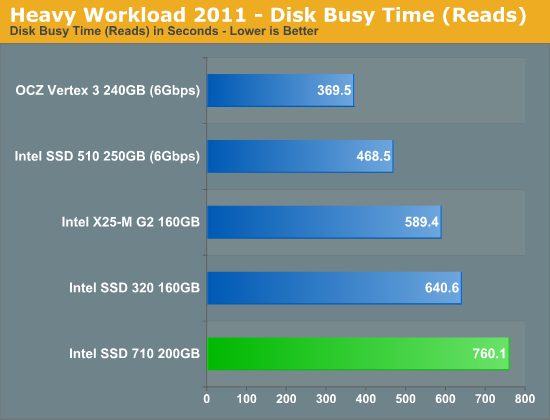
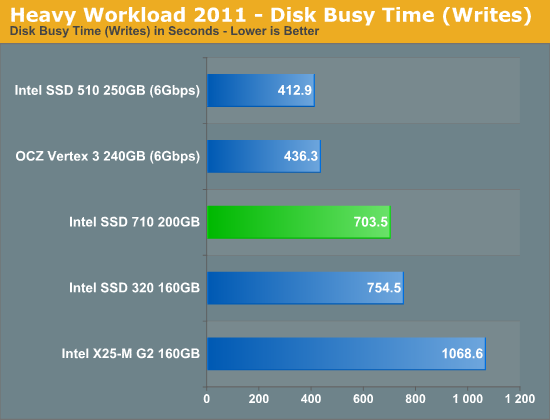










68 Comments
View All Comments
Lifted - Friday, September 30, 2011 - link
If you're going to wear a t-shirt without a jacket, at least have something geeky/nerdy on it. ;)METALMORPHASIS - Friday, September 30, 2011 - link
After buying one of these drives all you can wear is just a plain t-shirt.EJ257 - Saturday, October 1, 2011 - link
Yeah like a t-shirt that say "I Void Warranties"http://www.thinkgeek.com/interests/techies/8f52/
michal1980 - Saturday, October 1, 2011 - link
PM your addy, and I'll send you a tee shirt that has a new collar. yours is stretched out.ph0masta - Saturday, October 1, 2011 - link
I'm not in the IT biz, yet as a computer tech enthusiast I still find it interesting. I'd to learn more about the high performance warez that are required to run enterprise class computing.dananski - Monday, October 3, 2011 - link
Stop going off topic, this is clearly about T-Shirts. :PLinkpl4y - Saturday, October 15, 2011 - link
I wonder if you could fry an egg on an SSD.http://www.foodrepublic.com/2011/10/14/how-fry-egg...
AdamK47 - Friday, September 30, 2011 - link
This is a good review, but are SSD reviews going to be the only interesting thing for the PC builder/overclocking community to view? You know, the foundation of which AnandTech was build on. I remember all of the great reviews for 7+ years ago. If it weren't for the forums, I really wouldn't be here still. Where are the Sandybridge-E previews or the Bulldozer previews? How about some good old fashioned overclocking analysis? Throw in some good gaming benchmarks while you're at it. I couldn't care less about business IT hardware, efficient HTPC, or Apple related reviews. Is this where your analysis team has deemed the direction the site should go in?dac7nco - Friday, September 30, 2011 - link
In all fairness, IT hardware is interesting to quite a few people. There are a few places here and there that benchmark games. I agree about the Apple reviews; I couldn't care less, and neither would most sane people.B3an - Saturday, October 1, 2011 - link
I also couldn't care less for anything Apple related. But sadly Apple articles seem to get quite a lot of attention so i doubt they'll be going away. It's like everything that does well... after a while things start to get more mainstream and you cant get more mainstream than Apples useless toys. I have no problem with this review at all though, i just hope these kinda detailed reviews dont disappear.